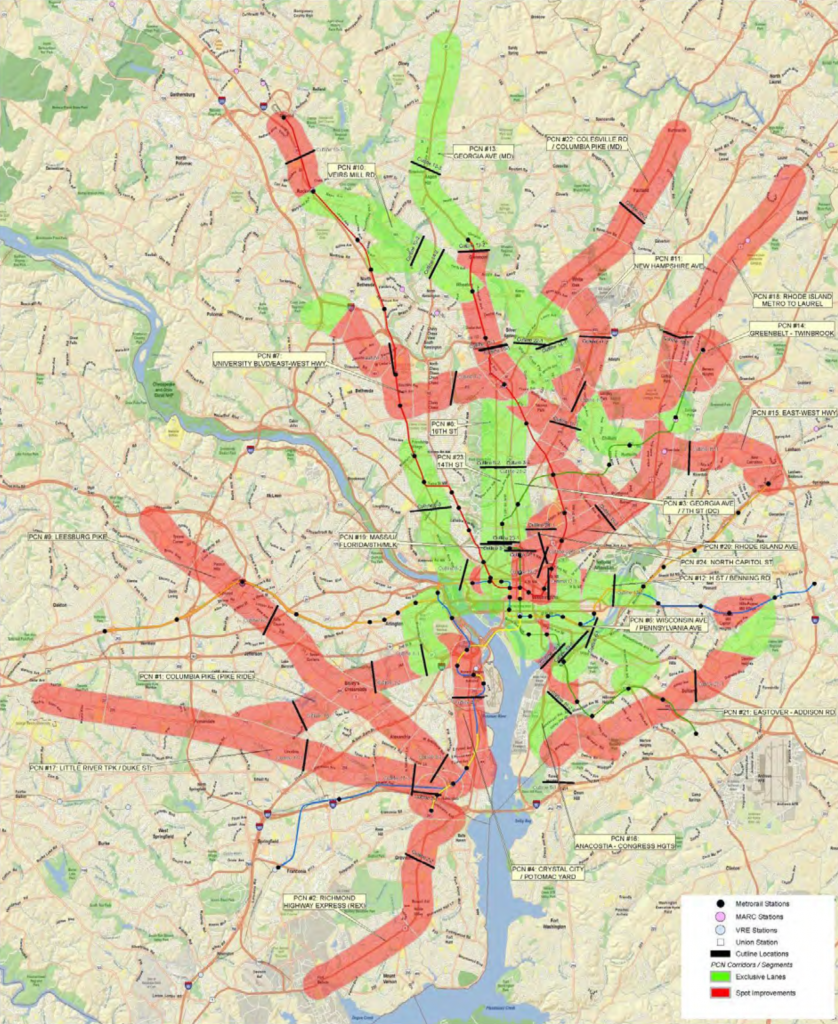Metrobus Priority Corridor Network Evaluation
Potential of Improved Running Ways to Increase Bus Ridership, Reduce Bus Operating Costs, and Increase Effective Road Capacity
Buses operating on surface streets in mixed traffic experience delay from a variety of sources, including traffic congestion, bus stops, traffic signals and passenger movements. As our region continues to grow and economic conditions make bus an ever-more appealing option for travelers of all kinds, Metrobus corridors experience more and more delay. This delay results in increased costs for bus passengers in terms of travel time, and increases the cost of providing bus service: additional buses and operators must be added to maintain desired service frequencies.
One of Metro’s proposed solutions to the increasing costs and continued degradation of bus service is the Priority Corridor Network (PCN). Metro has identified 23 high ridership corridors to receive priority treatments, which consist of both service adjustments as well as improvements to the bus (street) runningway. Service adjustments proposed include restructured routes and schedules, skip-stop operations and additional service overlays. Runningway improvements could include bus lanes, transit signal priority, queue jumpers, bus stop location, and off-board fare payment systems.

A map of the PCN, including recommended dedicated lane corridors in green and spot treatments corridors in red. Click image for larger version.
Metro is moving forward with implementing the service enhancements along many priority corridors, subject . Service adjustments have been implemented along the 70s lines (Georgia Ave/7th Street), the 30s lines (Wisconsin Ave / Pennsylvania Ave), and the S-lines (16th Street NW) in Washington DC; the Q2 line (Veirs Mill Road) in Maryland; and the Columbia Pike (PikeRide), Richmond Highway (REX) and Crystal City – Potomac Yard (9S) corridors in northern Virginia.
While the service adjustments component of the PCN implementation is entirely within the control of Metro, subject to the availability of funding regionally, nearly all runningway improvements require cooperation and coordination with the state and local departments of transportation (DOTs) who own and maintain the bus runningway (street) and bus stop (sidewalk) real estate.
In 2009, Metro and COG/TPB initiated a consultant study to evaluate the potential benefits and costs of implementing runningway improvements for the PCN. This study evaluated the need for dedicated bus lanes for the entire PCN, determining which segments could support such high priority treatments and which required a lower level of investment. The study’s final report (PDF, 6.5 MB), released on May 10, 2010, concluded that approximately 90 miles of the 235-mile PCN system warranted dedicated bus lanes, while the rest of the network warranted “spot” improvements at defined locations that generate significant travel time delay for buses. This priority network, when modeled and assessed for PCN implementation in the year 2030, is forecast to result in an additional 100,000 new daily transit trips and 90,000 trips diverted off of the congested Metrorail system. The PCN routes themselves are forecast to experience a 25% increase in ridership over the analysis base case, and a 15% increase in bus running speed. Travelers on the modeled PCN network are forecast to experience on average a 10% decrease in travel time, while average auto vehicle travel time should only increase by 2%.
Metro is in the process of sharing these results with the state and local DOTs, working with them to determine how these bus priority treatments can be implemented. Work on some of the corridors has already begun, funded by a $58.8 million TIGER grant awarded to the Transportation Planning Board on behalf of the Washington region.
Download the final study report. (PDF, 6.5 MB)


Recent Comments